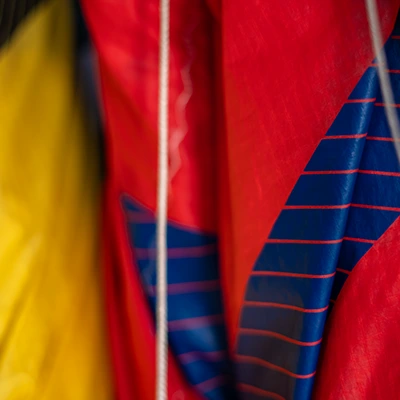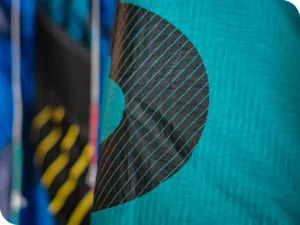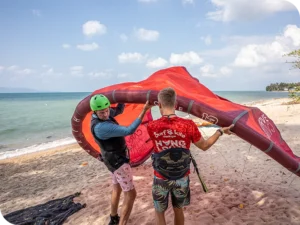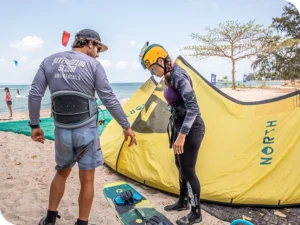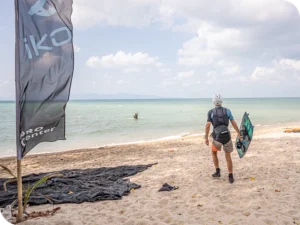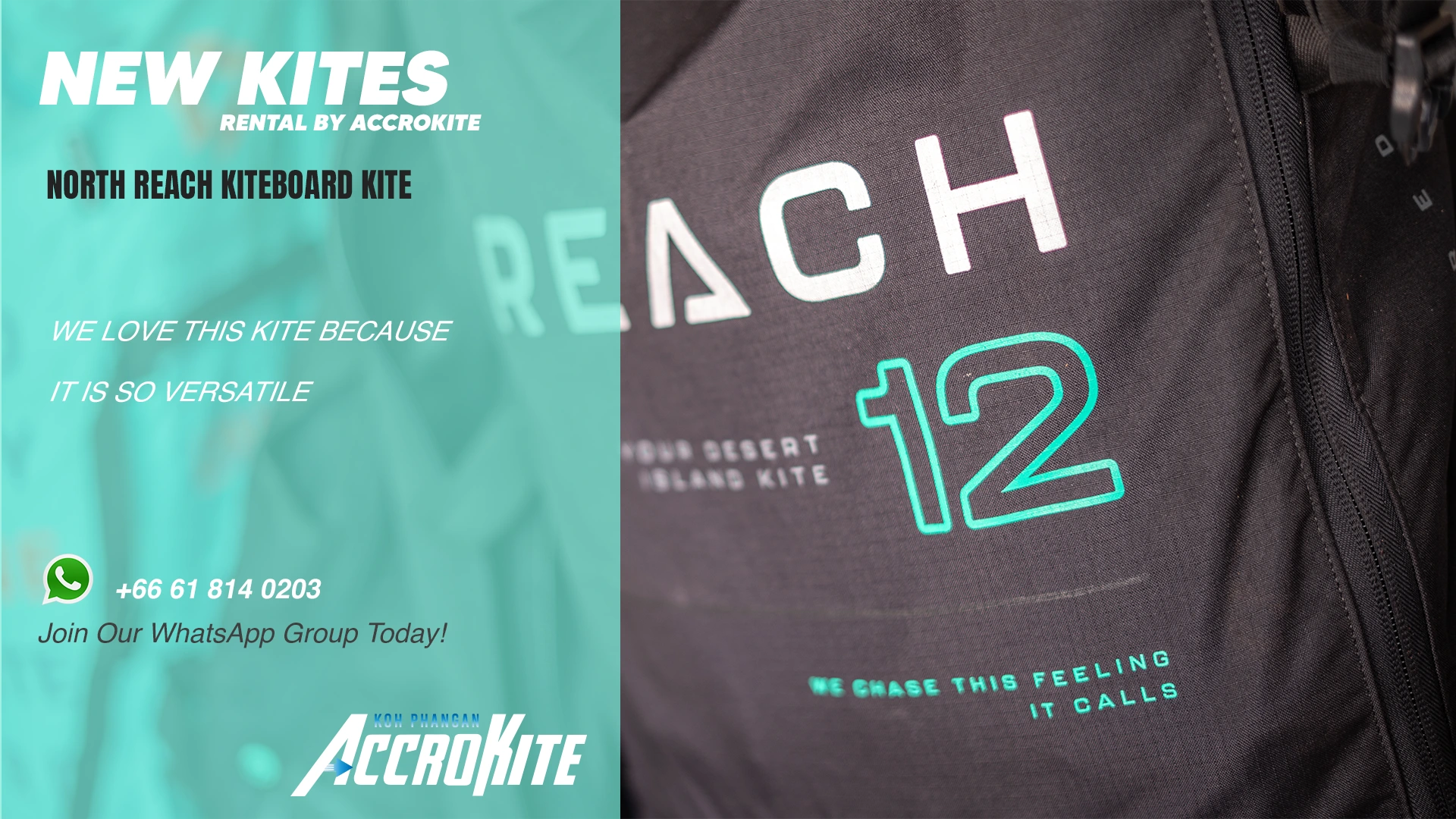
Kiteboarding, often referred to as kite surfing, stands as a thrilling water sport that blends the rush of adrenaline with the serenity of the open water. Central to this captivating experience is the kiteboarding kite, a fundamental apparatus that serves as the driving force behind every exhilarating ride. Harnessing the raw power of the wind, these kites propel riders across the waves with breathtaking speed and agility.
The kiteboarding kite serves as more than just a means of propulsion; it embodies the essence of freedom and adventure on the water. Crafted from durable materials and meticulously engineered for performance, these kites come in various shapes, sizes, and designs to accommodate riders of all skill levels and preferences. From freestyle enthusiasts executing gravity-defying tricks to wave riders carving through the surf, there’s a kiteboarding kite tailored to every rider’s unique style and aspirations.
As riders take to the water, the kiteboarding kite becomes an extension of their own movement and intent, responding fluidly to their commands and manoeuvres. With precise control and manoeuvrability, riders can harness the wind’s energy to navigate the waves with grace and precision, experiencing the exhilaration of flight on the water’s surface.
In essence, the kiteboarding kite serves as the catalyst for unforgettable adventures and unforgettable moments on the water, unlocking the full potential of kiteboarding as a dynamic and exhilarating sport. Whether soaring through the air with breathtaking leaps or cruising across the waves with effortless grace, riders can truly unleash the power of the wind with their trusty kiteboarding kite by their side.
The evolution of kiteboarding kites is a testament to human ingenuity and the relentless pursuit of adventure. While the concept of using kites for propulsion dates back centuries, it wasn’t until the late 20th century that kiteboarding kites began to take shape in their modern form.
Ancient civilizations, such as the Chinese and Polynesians, were among the first to harness the power of the wind with rudimentary kites, using them for transportation, fishing, and even recreation. However, it wasn’t until the 1970s and 1980s that kiteboarding as we know it today began to emerge.
During this time, pioneers like Gijsbertus Adrianus Panhuise and Corey Roeseler experimented with using kites for water sports, laying the foundation for what would become kiteboarding. These early kites were simple, diamond-shaped designs made from basic materials like nylon and wooden spars.
The true evolution of kiteboarding kites came in the late 1990s and early 2000s with significant advancements in kite design and technology. Innovations such as inflatable leading edges, bridle systems, and depower features revolutionized the sport, making kites more stable, controllable, and user-friendly.
Today, kiteboarding kites come in a variety of shapes, sizes, and styles to suit different riding conditions and preferences. From traditional inflatable kites to foil kites optimized for speed and efficiency, riders have a plethora of options to choose from.
Looking ahead, the evolution of kiteboarding kites shows no signs of slowing down. With ongoing advancements in materials, aerodynamics, and safety features, the future of kiteboarding promises even greater excitement and innovation for riders around the world.
At the core of every kiteboarding kite lies a complex arrangement of components meticulously engineered to harness the power of the wind and propel riders across the water with precision and control.
The canopy, crafted from robust materials such as ripstop nylon or polyester, serves as the kite’s outer skin. This durable fabric is designed to withstand the rigours of the elements while providing the necessary surface area to catch and harness the wind’s force.
Attached to the leading edge of the canopy is a reinforced structure known as the leading edge. Typically constructed from inflatable tubes or rigid rods, the leading edge provides crucial structural integrity to the kite, helping it maintain its shape and stability in flight.
Supporting the canopy and leading edge are a series of struts, which run perpendicular to the leading edge and extend outward to the edges of the canopy. These struts serve to reinforce the kite, preventing it from collapsing or deforming under the pressure of the wind. Additionally, they help maintain the kite’s aerodynamic shape, optimizing performance and efficiency on the water.
Integral to the operation of the kite are the bridle lines and attachment points. These lines are strategically connected to the canopy and leading edge, allowing the rider to control the kite’s movement and manoeuvrability. By adjusting the tension and angle of the bridle lines, riders can steer the kite, change its direction, and generate power for acceleration and jumps.
Together, these components form the intricate anatomy of a kiteboarding kite, working in harmony to deliver an exhilarating and dynamic riding experience on the open water. Whether soaring through the air with freestyle tricks or carving through waves with precision, the kiteboarding kite remains the ultimate tool for harnessing the power of the wind and unlocking endless possibilities on the water.
Kiteboarding kites come in a variety of types, each designed to cater to specific preferences, riding styles, and skill levels of kiteboarders. Understanding the different types of kiteboarding kites is crucial for selecting the right one to enhance your kiteboarding experience.
Inflatable kites, also known as leading edge inflatable (LEI) kites, are the most common type of kiteboarding kite. They feature inflatable leading edges and struts, which provide stability and shape to the kite when inflated. Inflatable kites are versatile and suitable for riders of all skill levels, making them popular choices for beginners and experienced kiteboarders alike.
Foil kites, also referred to as ram-air or soft kites, utilize a series of air-filled cells to maintain their shape and aerodynamic profile. Unlike inflatable kites, foil kites do not require inflation and can be packed down into a compact size for easy transportation. Foil kites are favored by experienced riders and are well-suited for disciplines such as foilboarding and snowkiting.
Hybrid kites combine elements of both inflatable and foil kites, offering a versatile and adaptable design. These kites typically feature inflatable leading edges and a foil-like canopy construction, blending the stability of inflatable kites with the performance characteristics of foil kites. Hybrid kites are suitable for a wide range of riding styles and conditions, making them a popular choice among intermediate to advanced riders.
Single strut kites feature a minimalist design with a single inflatable strut running along the leading edge of the kite. This lightweight construction offers excellent maneuverability and responsiveness, making single strut kites ideal for wave riding and freeride disciplines. Additionally, their compact design makes them easy to pack down and transport, perfect for traveling kiteboarders.
Delta kites are characterized by their delta-shaped canopy and swept-back wingtips. This design provides stability in a wide range of wind conditions and allows for efficient upwind performance. Delta kites are popular among freestyle and freeride riders for their predictable flight characteristics and smooth power delivery.
By understanding the different types of kiteboarding kites available, kiteboarders can make informed decisions when selecting the right kite to suit their individual preferences, skill level, and riding goals. Whether you’re a beginner looking for stability and ease of use or an experienced rider seeking high-performance capabilities, there’s a kiteboarding kite designed to elevate your kiteboarding experience.
Modern kiteboarding kites are equipped with a plethora of innovative features and state-of-the-art technologies that elevate the riding experience to new heights. These advancements are designed to enhance performance, safety, and overall enjoyment for kiteboarders of all skill levels.
Kiteboarding kites incorporate advanced aerodynamic principles to optimize lift, efficiency, and stability during flight. Sleek, streamlined profiles minimize drag while maximizing power generation, allowing riders to harness the wind’s energy more effectively.
Leading manufacturers utilize premium materials such as ripstop nylon and high-tensile polyester to ensure durability, longevity, and resistance to wear and tear. These materials are chosen for their strength-to-weight ratio, providing a balance of robustness and lightweight performance.
Safety is paramount in kiteboarding, and modern kites are equipped with intuitive safety features to mitigate risks and enhance rider protection. Quick-release mechanisms allow riders to instantly depower the kite in emergency situations, ensuring rapid and controlled descents to the water’s surface.
Kiteboarding kites are designed to respond seamlessly to rider input, offering precise control and manoeuvrability across a wide range of wind conditions. Responsive steering systems enable riders to adjust the kite’s angle of attack and power delivery with ease, facilitating fluid transitions between manoeuvres.
Reinforced construction techniques, such as double-stitched seams and reinforced leading edges, enhance the durability and structural integrity of kiteboarding kites. These reinforcements minimize the risk of canopy tears and bladder punctures, ensuring reliable performance even in challenging conditions.
Bridle systems play a crucial role in shaping the kite’s flight characteristics and responsiveness. Innovative bridle designs optimize aerodynamic efficiency, stability, and kite control, allowing riders to achieve greater precision and finesse in their manoeuvres.
Advanced safety and depower systems are integrated into modern kiteboarding kites to provide riders with greater control and peace of mind on the water. These systems enable riders to depower the kite quickly and safely, reducing the risk of overpowering and enhancing overall safety during challenging conditions.
Overall, the key features and technologies found in modern kiteboarding kites are engineered to deliver unparalleled performance, responsiveness, and safety for riders seeking the ultimate kiteboarding experience. Whether you’re a beginner learning the basics or an experienced rider pushing the limits of the sport, these advancements ensure that your kiteboarding kite delivers optimal performance and reliability every time you hit the water.
Choosing the right kiteboarding kite is a crucial decision that can significantly impact your riding experience on the water. With a wide array of options available, it’s essential to consider several factors to ensure you select the kite that best suits your needs and preferences.
One of the primary considerations when choosing a kiteboarding kite is your level of proficiency and experience. Beginner riders typically benefit from larger, more stable kites that offer forgiving handling and predictable performance. Intermediate and advanced riders may prefer smaller, more responsive kites that provide greater manoeuvrability and control.
Wind conditions play a critical role in determining the appropriate kite size for your session. Lighter winds require larger kites with ample surface area to generate sufficient power for riding. Conversely, stronger winds necessitate smaller kites to prevent overpowering and maintain control. Understanding the wind range of your kite ensures optimal performance in varying conditions.
Consider your intended use for the kiteboarding kite when making your selection. Are you primarily interested in freestyle tricks, wave riding, or cruising? Different kite styles and designs are optimized for specific disciplines, so choose a kite that aligns with your riding style and objectives. Freestyle riders may prefer high-performance kites with quick turning speeds and explosive lift, while wave riders may prioritize kites with excellent drift and stability in surf conditions.
Pay close attention to the kite’s size and wind range specifications, as these metrics provide valuable insights into its performance characteristics. Kite size is typically measured in square meters (m²), with larger sizes suitable for lighter winds and smaller sizes suited for stronger winds. The wind range indicates the range of wind speeds in which the kite performs optimally, allowing you to gauge its versatility and suitability for different conditions.
By carefully considering factors such as rider proficiency, wind conditions, intended use, and kite size, you can confidently choose the right kiteboarding kite that enhances your riding experience and unlocks new possibilities on the water. Whether you’re a novice rider embarking on your kiteboarding journey or an experienced enthusiast seeking to push the boundaries of the sport, selecting the perfect kite ensures maximum enjoyment and progression in your kiteboarding endeavours.
Setting up your kiteboarding kite is a critical step that can significantly impact the success and safety of your session on the water. A meticulous approach to rigging ensures that all components are properly assembled and secured, minimizing the risk of equipment failure and accidents during your ride.
Before you begin setting up your kiteboarding kite, choose a suitable location with ample space free from obstacles and obstructions. Lay out your kite on a clean surface, ensuring that the lines are untangled and free from knots or twists.
Start by attaching the kite lines to the control bar according to the manufacturer’s instructions. Ensure that the lines are correctly threaded through the bar and attached to the appropriate connection points on the kite.
Conduct thorough safety checks to verify that all components of the kiteboarding kite are secure and functional. Inspect the canopy, leading edge, struts, and bridle lines for any signs of damage or wear. Check the integrity of the stitching and seams, as well as the condition of the bridles and attachment points.
If your kite requires inflation, use a pump to inflate the leading edge and struts to the recommended pressure. Ensure that the valves are properly sealed to prevent air leakage during your session.
Adjust the control bar settings according to your preference and riding style. Ensure that the lines are equal in length and properly connected to the bar, with the correct line lengths for steering and power control.
Before launching the kite, review basic safety procedures and emergency protocols. Familiarize yourself with the quick-release mechanisms and safety systems on your kite and control bar, ensuring that you understand how to activate them in case of an emergency.
Once your kite is rigged and safety checks are complete, prepare for launch by positioning yourself upwind of the kite. Signal to your assistant or fellow riders that you are ready to launch, and carefully release the kite into the wind.
By following these steps and exercising caution throughout the setup process, you can ensure that your kiteboarding kite is properly configured for a safe and enjoyable session on the water. Taking the time to rig your kite correctly and conduct thorough safety checks instills confidence and peace of mind, allowing you to fully immerse yourself in the exhilarating experience of kiteboarding.
Launching and landing a kiteboarding kite safely is crucial for a successful and enjoyable session on the water. Whether you’re embarking on a thrilling ride or returning to shore, employing proper techniques and adhering to safety protocols is essential to minimize the risk of accidents and ensure a smooth transition.
When launching your kiteboarding kite, it’s important to choose an open area free from obstacles and bystanders. Position yourself upwind of the kite and signal to your assistant or fellow riders that you’re ready to launch. With the control bar in hand, gently steer the kite into the air by pulling on the control lines. Maintain steady tension on the lines to prevent the kite from collapsing or losing momentum. Once the kite is airborne, carefully manoeuvre it into the desired position and prepare for takeoff.
Similarly, landing your kiteboarding kite requires careful coordination and communication. Signal to your assistant or fellow riders that you’re ready to land, and guide the kite towards the designated landing area. Gradually depower the kite by releasing tension on the control bar and steering the kite towards the ground. As the kite descends, maintain control and prevent it from drifting or losing altitude too quickly. Once the kite touches down, secure the lines and ensure that it is safely stowed to prevent it from relaunching unexpectedly.
Throughout the launching and landing process, prioritize safety by maintaining clear communication with your assistant and fellow riders. Be mindful of wind conditions and potential hazards in the surrounding area, and always be prepared to react quickly to unexpected changes or emergencies. Familiarize yourself with the quick-release mechanisms and safety systems on your kite and control bar, and ensure that you understand how to activate them if necessary. By following these guidelines and exercising caution, you can launch and land your kiteboarding kite safely, allowing you to focus on enjoying the exhilarating experience of kiteboarding without compromising on safety.



